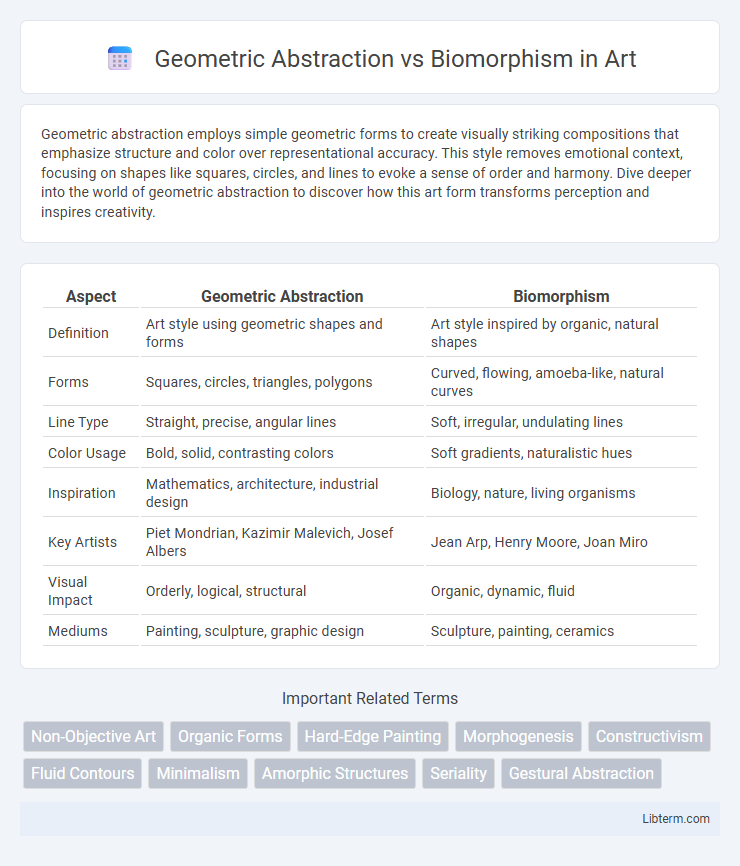Geometric abstraction employs simple geometric forms to create visually striking compositions that emphasize structure and color over representational accuracy. This style removes emotional context, focusing on shapes like squares, circles, and lines to evoke a sense of order and harmony. Dive deeper into the world of geometric abstraction to discover how this art form transforms perception and inspires creativity.
Table of Comparison
| Aspect | Geometric Abstraction | Biomorphism |
|---|---|---|
| Definition | Art style using geometric shapes and forms | Art style inspired by organic, natural shapes |
| Forms | Squares, circles, triangles, polygons | Curved, flowing, amoeba-like, natural curves |
| Line Type | Straight, precise, angular lines | Soft, irregular, undulating lines |
| Color Usage | Bold, solid, contrasting colors | Soft gradients, naturalistic hues |
| Inspiration | Mathematics, architecture, industrial design | Biology, nature, living organisms |
| Key Artists | Piet Mondrian, Kazimir Malevich, Josef Albers | Jean Arp, Henry Moore, Joan Miro |
| Visual Impact | Orderly, logical, structural | Organic, dynamic, fluid |
| Mediums | Painting, sculpture, graphic design | Sculpture, painting, ceramics |
Introduction to Geometric Abstraction and Biomorphism
Geometric abstraction emphasizes the use of simple shapes such as squares, circles, and triangles, creating compositions rooted in mathematical precision and order. Biomorphism draws inspiration from organic forms and natural shapes, highlighting curves and fluid lines that mimic living organisms' structures. These contrasting approaches define two major directions in modern art, with geometric abstraction focusing on rigidity and clarity, while biomorphism explores growth and natural rhythms.
Historical Origins and Key Influences
Geometric Abstraction emerged in the early 20th century, influenced by Cubism and De Stijl movements, emphasizing mathematical shapes, precision, and order, with key figures such as Piet Mondrian and Kazimir Malevich. Biomorphism, rooted in Surrealism during the 1930s, draws inspiration from organic forms, nature, and the subconscious, led by artists like Jean Arp and Henry Moore. Both styles reflect divergent responses to modernity, with Geometric Abstraction prioritizing structure and Biomorphism embracing fluid, natural curves.
Defining Characteristics of Geometric Abstraction
Geometric abstraction is defined by its use of precise shapes such as circles, squares, and triangles, emphasizing mathematical order and symmetry to create non-representational art. This style prioritizes clarity, structure, and often employs a limited color palette to highlight form and spatial relationships. Unlike biomorphism, which draws inspiration from organic, natural forms, geometric abstraction revolves around deliberate, clean lines and fundamental geometric principles.
Core Principles of Biomorphism
Biomorphism emphasizes organic, fluid forms inspired by nature, contrasting with the rigid, angular shapes characteristic of geometric abstraction. Its core principles focus on smooth, curvilinear lines and asymmetry, evoking living organisms and natural growth patterns. This art style aims to create a sense of life and movement through soft, rounded shapes that mimic biological forms.
Influential Artists in Geometric Abstraction
Pioneering figures in Geometric Abstraction include Kazimir Malevich, whose Suprematism emphasized basic geometric forms and pure artistic feeling, and Piet Mondrian, renowned for his grid-based compositions using primary colors that embody harmony and order. Wassily Kandinsky also contributed significantly by exploring non-representational shapes and color theory to evoke emotion through geometry. These artists laid foundational principles contrasting with Biomorphism, which emphasizes organic, fluid shapes inspired by natural forms.
Pioneers of Biomorphic Art
Pioneers of biomorphic art such as Jean Arp, Henry Moore, and Joan Miro emphasized organic, fluid forms inspired by nature, contrasting sharply with the precise geometric shapes favored in geometric abstraction. Their work often featured curvilinear, amoeba-like shapes that evoke living organisms, creating a sense of growth and transformation absent in rigid geometric compositions. This approach aimed to explore subconscious biological forms, expanding the boundaries of abstract art through naturalistic and dynamic structures.
Visual Language: Shapes, Forms, and Patterns
Geometric Abstraction employs precise, mathematical shapes such as squares, circles, and triangles, emphasizing clean lines and symmetry to create structured visual language. Biomorphism contrasts this by utilizing organic, flowing forms inspired by nature, characterized by curvilinear shapes and irregular patterns that evoke living organisms. Patterns in Geometric Abstraction are repetitive and grid-based, while Biomorphic designs feature asymmetrical, dynamic arrangements that suggest natural growth and movement.
Philosophical and Cultural Contexts
Geometric abstraction emphasizes rationality, order, and universal truths rooted in Enlightenment philosophy and modernist cultural movements, reflecting humanity's quest for clarity and objective knowledge. Biomorphism draws on organic, fluid forms inspired by nature and the subconscious, aligning with Romanticism and Surrealism's exploration of intuition, emotion, and the primal aspects of human experience. Both movements reveal contrasting cultural responses to modernity: geometric abstraction's structured precision counters biomorphism's emphasis on natural forms and ephemeral life forces.
Impact on Modern and Contemporary Art
Geometric abstraction, characterized by precise shapes and mathematical forms, revolutionized modern art by emphasizing structure and order, influencing movements such as Cubism and Minimalism. Biomorphism, with its organic, flowing shapes inspired by nature, contributed to contemporary art by fostering emotional expression and surrealist aesthetics. Both approaches reshaped artistic perspectives, fostering diverse explorations in abstraction and redefining visual language in 20th and 21st-century art.
Conclusion: Comparing Geometric Abstraction and Biomorphism
Geometric Abstraction emphasizes precise shapes, symmetry, and mathematical order, reflecting rationality and structural clarity in art. Biomorphism, by contrast, embraces organic, fluid forms inspired by natural life, highlighting spontaneity and emotional resonance. Both styles offer distinct approaches: Geometric Abstraction prioritizes controlled composition, while Biomorphism fosters expressive, naturalistic aesthetics.
Geometric Abstraction Infographic

 libterm.com
libterm.com